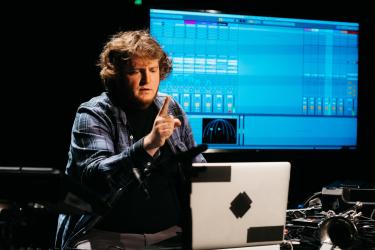New summer classes empower performance community to use cutting-edge technologies

After rebounding from a major flood with vibrant new leadership and a new toolbox of performance technologies, the ATLAS Institute’s B2 Center for Media, Arts & Performance now offers more varied and interesting opportunities to artists, engineers, creative technologists and performers than ever before. As challenging as the post-flood refit was, it provided B2 with the opportunity to install some exciting new capabilities into the Black Box Experimental Studio and the other spaces that make up B2. Topping this list are an 8-camera motion capture system, a 44-speaker spatial audiosonic array and the latest in low-latency video relay technology.
What possibilities does this open up? They are endless: With the physical movement of performers digitized, it can be processed and projected in the same space with appearances transformed into, say, an animated character or moving points of light or whatever an artist can dream up. Physical movement can also be programmed to trigger certain sound events that, projected across the 3D audiosonic array, are percieved differently, depending on where the listener is in the space.
Confused? That's understandable; there's nothing familiar about these technologies. "There's certainly no other facility in Colorado with these capabilities, and there are probably only a handful in the whole country," says Ondine Geary, executive director of B2.
To make these technologies more accessible to the community, the ATLAS Institute is offering two new summer classes in August: one focused on using the motion capture technology and the other on the 3D audiosonic system.
“These classes will empower the community by teaching them how to use the new technologies,” said Geary. “I'm excited to see what ideas emerge and how the use of these technologies evolves.”
Both classes emphasize the design elements and skills needed to utilize the technologies in a performance context. The curricula will accommodate undergraduate and graduate students with varied skills and objectives, including technologists, performers, designers, choreographers and composers. The intensive courses will be taught over three weeks during Augmester, so as not to disrupt artists during their B2 residencies.
Intermedia Motion Capture (ATLS 3519-051)—focuses on the motion capture technology in performance and serves as a broad overview to the technology available in the ATLAS Black Box; students will use the motion capture system to interact with the ambisonic sound system, DMX controlled LED lighting and 360-degree video projection.
Immersive Audio & Ambisonics (ATLS 3519-052)—focuses on the applications of immersive audio technologies in both media production settings and live performance contexts. The course focuses specifically on understanding the basics of immersive audio and then applying, prototyping and iterating these concepts hands-on with the spatial audio system.
Brad Gallagher, an ATLAS-affiliated PhD student in Intermedia Art, Writing and Performance, created and will teach “Performance Technologies: Intermedia Motion Capture,” which focuses on non-traditional uses of motion capture technology, particularly those applicable to live performance, including generating sound with movement, controlling and affecting lighting and interacting in real time with 360-degree video projection. To a lesser degree, the course also covers using motion capture to create animation through skeleton tracking. The goal of the course will be to produce solo and collaborative performances using these technologies.
Sean Winters, an ATLAS-affiliated lecturer for the Department of Critical Media Practices and the College of Music, created and will teach “Performance Technologies: Immersive Audio & Ambisonics,” where students will learn how to use the 44-channel audio system in the ATLAS Black Box Experimental Studio. Students will produce sonic content from scratch for ambisonic diffusion, record 3D sound fields and become familiar with the specific tools needed to edit/mix ambisonic content. Technically, they will gain advanced knowledge of immersive audio production, ambisonic recording techniques and a solid understanding of how to employ these concepts using the ATLAS Black Box’s state-of-the-art audio system.
Geary says the courses involve historical and theoretical information, but the real thrust is to “get your hands dirty and use these tools.”
She envisions participants meeting artists from multiple disciplines and establishing collaborative relationships.
“Technological know-how is one component, but understanding how, when and why to implement those technologies in art-making is also an important component,” she said. “Students can expect to gain enough understanding of these tools to be able to expand their creative practices. These courses will give them the confidence to independently use these technologies. ”
[video:https://vimeo.com/530168490]
Brad Gallagher's "Rumpus Room for Dancers" demonstrates motion capture triggering specific sounds. His project will be exhibited at the Currents New Media Festival in Santa Fe in June.


